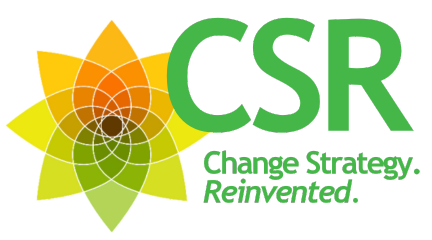
This article, written by CSR Communications’ CEO, Nancy Murphy, was originally published in The Business Journals Leadership Trust.
We now live in what futurist Jamais Cascio calls a “BANI world” — brittle, anxious, nonlinear and incomprehensible. The term may sound alarmist, but it rings true for anyone leading an organization today. Change no longer arrives in predictable ways or manageable packages. It crashes through our carefully laid plans.
According to Accenture’s 2024 Pulse of Change Index, the rate of change has jumped 183% since 2019. Meanwhile, our collective capacity to absorb that change has been eroded by chronic stress and weakened workplace support systems dating back to the pandemic. We’re navigating significant disruption with depleted emotional reserves.
My company, CSR Communications, has worked on dozens of change projects during more stable times, and helped hundreds of leaders prepare for and adapt to change during disruptions, including the 2008 recession, the COVID-19 pandemic, and now. Through this work, we’ve identified the essential practices that distinguish organizations that fold from those that flourish.
I share a few of those essential practices here.
Typical Solutions That Fall Short
Let’s review leaders’ usual solutions and why they often fail or deliver mediocre results.
• One-and-done training: Rarely enough for basic skills, and it’s woefully insufficient for the challenges of leading through persistent upheaval.
• Traditional leadership development: Develops skills for stable environments, not the extreme leadership that today’s conditions demand.
• Rigid change-management frameworks: Too often focused on checklists and Gantt Charts rather than the human psychology that makes change stall or succeed.
• Technology: Leaders forget that adopting tech solutions is also change that needs to be managed. This exacerbates change exhaustion among employees. Many leaders advocate AI as a quick fix for overworked employees, but without proper guidelines or change management, that too will fail.
• Command-and-control leadership: A reflexive response to leader anxiety that ultimately erodes trust and engagement (think rigid return-to-office policies and keystroke-tracking software).
• Wellness programs: Many employees see these well-intentioned efforts as disingenuous and a waste of money, treating symptoms rather than addressing root causes.
The hard truth is you can’t use Gantt charts and checklists to guide you through human emotional reactions to change. Organizations that try face a downward spiral of change resistance: initial curiosity misinterpreted as opposition, leading to defensive leadership reactions, which trigger genuine resistance, eventually resulting in exhaustion or outright revolt.
Two Essential Leadership Capabilities Every Organization Needs
Today’s organizations need two seemingly contradictory leadership capabilities: speed and discernment.
Speed without discernment is like driving fast with your eyes closed. You get somewhere quickly, but rarely where you intended, and often with dire consequences. Discernment without speed leads to analysis paralysis and missed opportunities.
The organizations that will thrive through 2025 and beyond are those that develop both capabilities — and know when to emphasize each.
Four Practices of Change-Capable Organizations
The most adaptive organizations I’ve worked with follow these practices to navigate continuous disruption effectively:
1. Robust role clarity
In stable times, some role ambiguity is manageable. In disruptive environments, it’s lethal.
Change-capable organizations document crystal-clear roles on three dimensions: decision authority (who makes what decisions), responsibility boundaries (what each person owns) and cross-functional handoffs (how work moves between teams).
When roles are muddy or not updated frequently enough, people waste precious time and energy on unnecessary conflicts and duplicated efforts, middle managers feel disempowered or overstep, or, worst of all, critical gaps emerge where everyone assumes someone else is handling an essential responsibility.
2. Communication that builds trust, not just transmits information
During periods of significant change, trust becomes the oxygen that allows everything else to function.
Change-capable organizations approach communication as relationship-building, not just information transfer.
This means:
• Meeting people where they are emotionally before pushing for acceptance.
• Acknowledging uncertainty and normalizing shifts in strategy.
• Over-communicating through multiple channels, not just emails and Town Halls.
• Acting on feedback — and never asking for input on things you won’t or can’t act on.
3. Consistent commitment and calculated risk
The New York City cab driver approach to change — accelerate, brake, swerve — leaves people feeling nauseous, disoriented and a little jerked around.
Change-capable leaders maintain consistent commitment. This doesn’t mean rigid adherence to failing strategies. Instead, it means taking calculated risks, experimenting and providing security while the next stage of change unfolds.
Change-capable organizations communicate clearly about what is known and unknown, identify what won’t change even when circumstances do (e.g., core values) and normalize course correction as smart adaptation, not failure.
4. People-first, not process-first
Organizations don’t change if people don’t change. The most sophisticated process framework will fail if it doesn’t address the human psychology of change.
Change-capable organizations recognize that resistance isn’t obstinance — it’s a natural human response to loss, uncertainty and perceived threats to autonomy or status. They address these concerns directly by:
• Building change readiness across all leadership levels, not just the C-suite.
• Investing in the capabilities of middle managers as change enablers.
• Identifying and addressing organizational “artifacts” — the systems, symbols and practices that contradict the desired change.
• Leveraging the early “change curiosity” phase to build momentum rather than create real resistance.
The Cost of Waiting
For organizations tempted to wait until conditions stabilize before tackling these fundamentals, consider this: Every day of delayed action has real costs. There’s the obvious toll on your mission and financial performance. But the hidden costs are often more severe: the loss of critical talent, erosion of trust and morale, and the cumulative impact of poor decisions made under increasing pressure.
The best time to build these capabilities was before the current turbulence. The second-best time is now.
Organizations that emerge strongest from this period won’t be those that avoided change or waited it out. They’ll be those that transformed how they approach change itself, making the ability to adapt a core organizational capability rather than a periodic necessity.
With the right foundations in place, change shifts from a threat to be feared to a strategic advantage for future growth. And in today’s BANI world, that might be the most sustainable advantage of all.
If your organization is ready to move beyond checklists and crisis mode reactions, CSR Communications can help. We work with mission-driven leaders to embed sustainable change capacity at every level, from clarifying roles to aligning systems with new strategies. Contact us here to learn how we can support your team in building the muscle to thrive through disruption.



